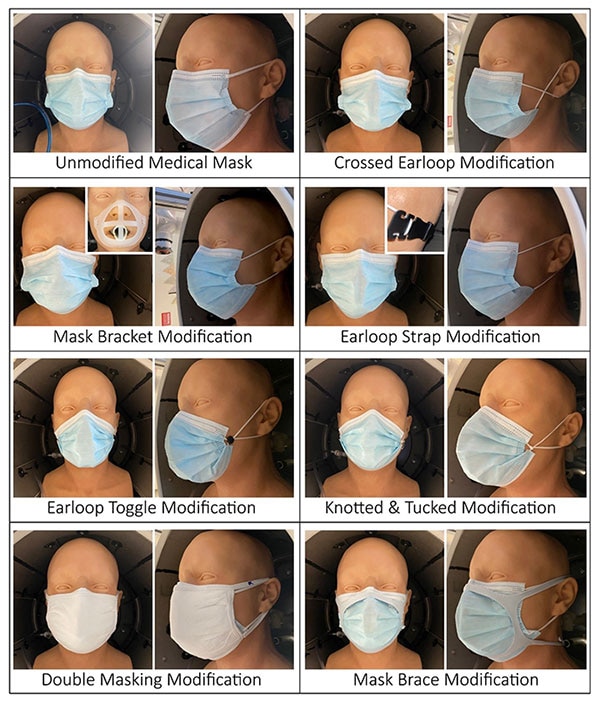Editor’s note: Find the latest COVID-19 news and guidance in Medscape’s Coronavirus Resource Center.
Certain modifications to face masks, such as double masking and adjusting the fit more tightly around the face, can greatly reduce the transmission of respiratory particles, says a study involving five types of masks, eight modifications, and both mannequins and human subjects.

Francoise Blachere
“Wearing a face mask to protect others from potentially infectious aerosols and droplets, called source control, has been shown to be a highly effective infection control strategy to limit the spread of COVID-19,” write Francoise M. Blachere, MSc, of the National Institute for Occupational Safety and Health, Morgantown, West Virginia, and colleagues.
Pandemic recommendations continue to call for mask wearing in various settings, regardless of vaccination status, but face seal leaks allow respiratory aerosols to escape vs passing through the mask filtering material, the researchers say. Data on the effectiveness of proposed modifications to improve mask fit, such as mask braces, earloop straps, knotting/tucking, and double masking, are limited, they note.
In a study published in the American Journal of Infection Control, the researchers evaluated several modifications to improve the fit of a medical or cloth face mask and reduce the amount of escaping aerosols. The masks evaluated were a disposable protective medical mask and a disposable protective surgical mask (both with elastic earloops and adjustable metal nose strips), a reusable two-ply polyester blend cloth mask with earloops, a three-ply cotton face mask with earloops and adjustable metal nose strip, and a four-ply cotton/polyester blend mask with earloops and adjustable metal nose strip.
The researchers simulated coughs and exhalations and measured the efficiency of the various masking modifications for blocking respiratory aerosols.
Overall, layering a three-ply cloth mask over a medical mask (double masking) and securing a medical mask with a brace provided the best protection against respiratory aerosols.
Unmodified medical masks blocked 56% or more of cough aerosols and 42% or more of exhaled aerosols. By comparison, adding a cloth mask on top of a medical mask blocked 85% or more of cough aerosols and 91% or more of exhaled aerosols, and adding a brace over a medical mask blocked 95% or more of cough aerosols and 99% or more of exhaled aerosols.

Examination of filtration efficiency and inhalation airflow resistance showed differences among the materials of medical and cloth masks. Overall, the filtration performance of cloth masks was twofold to fourfold lower and the airflow resistance was higher compared to medical masks.
In fit tests on mannequins and human subjects, mask-fitting modifications of
crossing the earloops or using a mask bracket decreased the fit of both types of medical masks. However, using earloop toggles or an earloop strap, or knotting and tucking the mask, increased performance of medical masks compared to medical masks without modification. Using a mask brace improved fit for both medical masks and cloth masks.
The study findings were limited by several factors, including the focus on only five masks from the many available options, and by the use of simulation for cough and exhalation, which cannot account for the variation in breathing flow for individuals under different physiologic conditions, the researchers note.
However, the results yielded “practical combinations of face masks and mask modification devices that improved the mask seal and reduced the expulsion of respiratory aerosols into the environment,” the researchers write. “These mask fit modifications can be implemented by healthcare workers, patients, and the general public alike,” and the results can be broadly applied to reduce the transmission of other respiratory pathogens beyond COVID-19 and the current pandemic, they conclude.
“The study is important because face masks continue to be used to reduce the spread of infectious viruses such as SARS-CoV-2 that are transmitted by respiratory aerosols and droplets produced during activities such as talking, coughing, and breathing,” lead author Blachere told Medscape in an interview. “In this study, our group evaluated various modifications that aimed to improve the fit of a medical or cloth face mask and reduce the amount of expelled aerosols,” she said.
Blachere highlighted the finding that a medical mask was better at blocking coughed and exhaled aerosols of all sizes when the fit of a medical face mask was improved with a brace or layered with a cloth mask (double masking). “The improvements that we saw were most pronounced for smaller aerosols (≤3.3 µm in size), which is important because smaller aerosols can stay airborne longer and travel deeper into the lungs when inhaled,” Blachere said.
The key message for clinicians and the public is that the performance of face masks for controlling the spread of infection is twofold, dependent upon “both the ability of the mask material to filter aerosols, and on how well the mask fits the wearer,” she emphasized.
Barriers persist to proper face mask use. “People may be less willing to wear masks or may wear them incorrectly if the mask is uncomfortable, doesn’t fit well, or is hard to breathe through,” said Blachere. “It may help to try different masks in order to find one that is most comfortable. Finding a mask with a metal band that seals well around the nose or adding a mask fitter over the mask may help reduce fogging of eyeglasses, which is a common problem,” she noted. She added that current CDC guidelines on face masks and fit modifications can be found on the CDC websites: https://www.cdc.gov/coronavirus/2019-ncov/prevent-getting-sick/about-face-coverings.html and https://www.cdc.gov/coronavirus/2019-ncov/your-health/effective-masks.html.
“Future studies will look at how well different mask designs and materials work and will study how the performance of the mask is affected by different breathing rates and cough volumes, Blachere explained. “We also hope to develop a model that can predict how well the mask blocks coughed and exhaled aerosols using widely used standard tests of filtration performance and fit.”
Promoting Proper Mask Fit Makes a Difference
“Improvements in the function of masks are important for reducing transmission risk in the healthcare environment, as well as in the general community,” William Schaffner, MD, past president and current medical director of the National Foundation for Infectious Diseases, said in an interview with Medscape.

Dr William Schaffner
Schaffner was not surprised by the study findings. “The authors have demonstrated that several mask modifications can make masks fit more securely around the cheeks and chin, thereby improving their function in reducing the dispersal of aerosols by the wearer, source control,” Schaffner said. “They also reinforce the concept that double-masking, adding additional layers, likewise improves mask performance.
“These are well-known principles, and it is important to have additional data in confirmation,” said Schaffner. But “in the general population, the issues are more basic, namely, persuading people to wear any mask in indoor environments, as well as to remind them to wear the mask properly. As an example, all too frequently the mask does not cover the nose.
“The take-home message is to wear a mask that fits well, and if a cloth mask is used, to make sure that it consists of at least two layers of material,” Schaffner emphasized.
The researchers had no financial conflicts to disclose. Schaffner had no financial conflicts to disclose. He also serves as NFID liaison to the Advisory Committee on Immunization Practices at the Centers for Disease Control and Prevention.
Am J Infect Control. Published online December 15, 2021. Full text
Heidi Splete is a freelance medical journalist with 20 years of experience.
For more news, follow Medscape on Facebook, Twitter, Instagram, and YouTube.
